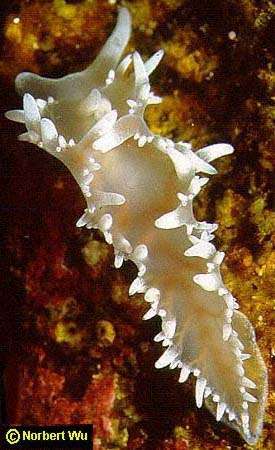
Notaeolidia depressa
Eliot, 1905
Order: NUDIBRANCHIA
Suborder: AEOLIDINA
Family: Notaeolidiidae
DISTRIBUTION
Circumpolar distribution including Antarctic Peninsula from depths of 30 to 429 meters
PHOTO
McMurdo Sound, Antarctica. This photo is published with the permission of Norbert Wu from the Underwater Field Guide to Ross Island & McMurdo Sound, Antarctica .
(Preserved length up to 65mm). Note the branching of the digestive gland visible through the body wall.
Notaeolidia depressa is translucent white and as can be seen clearly in the photograph, its brown or red digestive gland ducts can be seen through the body wall.
The genus Notaeolidia is known only from Antarctica. It is considered to be the most primitive genus amongst the aeolids. One primitive feature is the radula, which is similar to that of a Flabellina but with up to six lateral teeth on each side of the central, compared with one in Flabellina. Other unique characters are the arrangement of the cerata in longitudinal rows along the edge of a relatively wide mantle brim. In Notaeolidia depressa there can be either one row of cerata (as in this photo), or two. No information is available on its food, although Notaeolidia gigas feeds on tubularian hydroids.
As discussed under Austrodoris kerguelenensis, the taxonomy of antarctic nudibranchs has been hindered by too few specimens. Wagele (1990) considers that five other species, (N. rufopicta, N. robsoni, N. subgigas, N. alutacea, N. flava) are synonyms of N. depressa. This reduces the number of species in the genus to three, including N. gigas and N. schmekelae.
Reference:
• Wagele, H.(1990): Revision of the antarctic genus Notaeolidia (Gastropoda, Nudibranchia), with a decription of a new species. Zoologica Scripta 19(3), 309-330.
Rudman, W.B., 1999 (February 10) Notaeolidia depressa Eliot, 1905. [In] Sea Slug Forum. Australian Museum, Sydney. Available from http://www.seaslugforum.net/factsheet/notadepr
